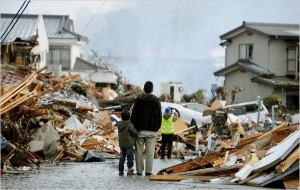Called “a great test for all of the people of Japan” by Japanese Prime Minister Naoto Kan, the 9.0-magnitude earthquake and

subsequent tsunami that ravaged Japan on March 11 have painted visions of destroyed homes and echoed stories of homelessness, fear, and panic within the people. Swallowing farming districts and cities in northeastern Japan, the tsunami also cautioned the Pacific coasts of North and South America, as well as Hawaii. Currently, the death toll in Japan has reached 7,500 with another 2,611 people wounded and 11,700 missing.
Since the natural disasters, thousands of people have been evacuated while others remain in shelters and have little or no access to food, water, electricity, gasoline, and medical supplies. With the roads still sprinkled with debris, transporting resources and other foreign aid has proven to be cumbersome. “I have no words to express my feelings. I lost my mind. We will have to start from zero,” one local, Hidemitsu Ichikawa, said about his destroyed home. In addition to the lack of resources, the “near freezing” weather in Japan is exacerbating health concerns. Kazuhiro Fujino, Captain from the Maritime Self-Defense force, agrees: “There is no medicine. Nothing. My biggest fear is that a flu epidemic is going to break out. There would be little we could do to stop it. It would take many more lives.”
But perhaps, the biggest obstacle complicating the recovery process is the nuclear concerns surrounding the Fukushima Daiichi Nuclear Plant, which was severely struck and affected by the earthquake and tsunami. Following the earthquake, radiation was released, and the tsunami engulfed the generators essential to keep water pumping in order to cool the reactors and prevent any nuclear meltdowns. According to reports, radiation levels peaked at 20 millisieverts per hour whereas typical residents are naturally exposed to 3 millisieverts per year. The government has urged people to stay away from the plant and be examined for radiation exposure.
China, Russia, and people in Japan have already accumulated potassium iodide pills, used to safeguard the thyroid gland in case of exposure which is highly sensitive to radiation. However, the Japanese Health Ministry revealed radiation levels in milk and spinach from farms nearby the Fukushima Plant, but were small enough to not pose any health dangers. It was also indicated that radioactive iodine was discovered in drinking water on March 17, but later testing showed that the level had declined. As of now, tests are being conducted on other foods, and food shipments are being ordered to stop if they are contaminated with radiation.
The situation in Japan as it stands right now is very fragile with hysteria rampant as “people are exhausted from the earthquake, tsunami, and now the fear of radiation. It [is] so far beyond anything we ha[ve] ever experienced,” Masaaki Tashiro, Principal of Koyo High School, states.
Despite the problems Japan is facing, an outpour of relief aid and support has come from 114 countries and over 24 international organizations, not to mention donations from schools and celebrities. Confident and determined in Japan’s resurgence, Kan declares, “We don’t have any room to be pessimistic. We are going to create Japan again from scratch. We should face this challenge together.”







